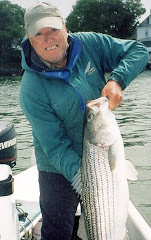Two
Handed Fly Rods Growing In Popularity.
Photo
Caption: Double handed fly rods aren't just Spey rods used for Atlantic salmon fishing today. New developments have expanded the concept of using two hands while fly fishing for other species.
photo credit: Mike Laptew photo of Captain Doug Jowett on Martha's Vineyard, Cape Cod, MA, USA.
Do you know what a two handed fly rod is?
Really, do you know? I suspect that many anglers might say, “Ya, it’s a Spey
Rod”. Well, that is one form of double handed fly rod. But, in the past fifteen
years and especially the last five; double handed fly rods have been seeing
measurable leaps into technological changes as well as applications on the
water.
Spey rods originated out of
necessity on the River Spey in Scotland
I began using 16 foot Spey rods
for Atlantic salmon fishing about 1980 and struggled to learn some of the
casting techniques using a floating line of 10 to 15 weight forward lines. I
did ok, but not really great. What were needed were more specific fly lines for
Spey casting. They were developed for floating lines only.
As time
pasted, other fisheries saw the advent of double handed rod use, especially for
steelhead fishing on the west coast where the need for long casts with heavy
sink tips were in demand. This demand led to the development of different
actions of double handed rods which were faster action as apposed to the
European action which lend themselves to the beautiful snake like Spey casting
we have all seen. That rod lead to what
now is called a Skagit rod having the
faster action needed to handle short fly line heads weighing from 300 to 600 grains of weight while
fishing steelhead. The name Skagit coming from the river
so named in Washington State British Columbia Canada
I began using my long Spey rods
with traditional 500 to 600 grain weight shooting heads and very large flies
for striped bass fishing about 1986. This delivery system worked great in the
wind using mega flies for presenting to large stripers. One issue was the soft
action which didn't fight a fish real fast. Skagit rods became part of the
answer to that issue.
As time passed, double handed
rod use has expanded to other fisheries. Demand for rods applicable to trout
fishing or smallmouth bass evolved. Switch rods were engineered to accommodate
more traditional overhead casting, bring the option of very long casts to those
fisheries. Switch rods are rightfully named as anglers can switch from single
to two handed techniques without changing the grips. Their lengths tend to be
in the ten to 11 foot range, so using single hand casting is doable with the
light weight of today’s rod blanks. Line weights range from four to ten with
line weights of the head section being from 200 to 700 grains.
Next comes the most recent
additional to the two handed rod development in the form of rods with two butt
sections. One section for traditional one hand casting and a second butt
section for use of two hands when necessary.
Temple Fork
Outfitters now has two lower rod sections designed to replace the single-handed
grip section on existing seven and eight weight, nine foot, four piece TiCrX
fly rods. With a total of six rod sections of equal length you can now have
both, a great nine foot, four-piece traditional fly rod, and a five-piece 11
foot, three inch, two-hander for easy overhead distance casting. This system is
being referred to as a convertible rod.
So, there you
have it. Double handed fly rods come in the form of Spey, Skagit , switch and
convertible configurations. That’s a big change from the previously recognized
two handed fly rods being classified into one class called Spey rods.
Captain Doug Jowett is a Master Maine
Guided holding a USCG Captain’s License who charters on the coast of Maine and
Cape Cod. He may be reached at: http://www.mainestripedbassfishing.com
.



No comments:
Post a Comment